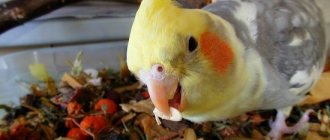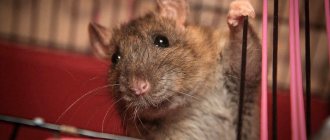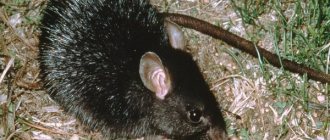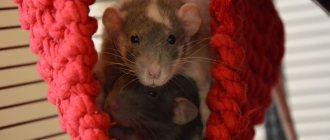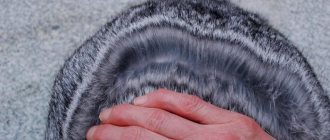What do rats eat in the wild?
Living in the wild, rats prefer to feast on:
- seeds;
- nuts;
- root vegetables and fruits;
- succulent stems of various crops;
- bird eggs;
- insects;
- larvae;
- worms;
- freshwater shellfish;
- fish fry.
To raise a healthy rat, you need to feed it properly.
Wild rodents can even hunt: they happily feed on toads, lizards, small species of birds and mammals. A similar diet prevails in the summer months. During the cold season, rodents move to live closer to people, feeding on grain stored in the barn and leftover human food.
Note! Rats that cannot find food for a long period of time can attack even a small pet.
Feeding during illness
You need to pay attention not only to mothers and babies, but also to sick pets who require no less careful care.
Antibiotics
If the rat suddenly begins to deteriorate, move less and even go bald, then it is important to take immediate action. It is better, of course, to consult a veterinarian, but there are medications that you can use to cure the animal yourself.
Warning: handle them carefully, otherwise treatment together will cause complications!
What remedies can be chosen to treat a rat:
- Azithromycin is available in the form of a syrup or sweet suspension. For an adult rat, you need 0.2-0.4 ml of antibiotic at a time for two weeks.
- Levofloxacin is contraindicated in young animals, and adults are given in the following doses - 0.1 mg diluted in 10 ml of water and given once a day for two to three weeks.
- When treated with doxycycline, the rat is prohibited from drinking milk. And for one individual this dose is 5-8 mg per kilogram twice a day for half a month.
- The veterinary antibiotic Baytril should be injected intramuscularly at 5%, and if subcutaneously, it should be diluted to 2.5% or less to avoid necrosis. One dose - 0.05 ml.
Antiviral
You can be treated not only with chemicals, but also with folk remedies. Help against infections and viruses: echinacea (diluted in water), ginseng (a couple of drops per day, added to food), propolis (used both internally and externally when wiping wounds and irritations).
Against arthritis
The symptoms of this painful disease can be relieved with the help of propolis, boswellia and martinia root.
Antitumor products
Ginkgo Biloba tincture - two drops three times a day - can eliminate pain (but, unfortunately, not completely cure) a brain tumor. A couple of drops of ginseng will help with colon cancer. Fresh garlic will delay the development of metastases and prolong the life of the rat.
What to feed your pet rat
What do mice eat in nature and at home - list of products
What do domestic rats eat? Rodent owners lacking experience make many mistakes when choosing a diet for their pets. It is not uncommon for rats to be given table scraps. Such a diet can cause various pathologies of internal organs. In order for the little rat to grow up healthy, it is important to balance its menu. Below you can see the different types of diet.
Daily menu
What to feed your pet rat? When compiling a daily diet, you should give preference to the following foods that animals like to eat:
- dill, cilantro, various types of lettuce, parsley;
- radish and dandelion leaves, celery;
- wheat sprouts;
- oats and other grains;
- boiled vegetables;
- potatoes, mashed potatoes, white turnips, cucumbers and cabbage leaves;
- fresh fruits (citrus fruits such as lemons, tangerines and oranges are introduced with extreme caution to avoid an allergic reaction);
- berries (rodents especially love fresh raspberries);
- dairy products (cottage cheese, kefir, yogurt, sourdough);
- corn, oatmeal.
The rodent's diet should contain a sufficient amount of vegetables and fruits
What to feed a decorative rat in winter? In the cold season, it is worth enriching the daily menu with a small amount of:
- barley;
- millet;
- wheat cereal;
- sunflower grains;
- nuts (almonds should not be given);
- soy feed;
- eggs (it is better to use quail eggs);
- pork, chicken and turkey fillet.
To replace meat products, you can use wet food for kittens or low-fat fish.
Note! If you want to give your pet an apricot or peach, you should first remove the seeds, which contain cyanide, from the fruit. These substances have a negative impact on the health of rodents.
What else can rats do? Some treats you can give your rat occasionally to praise it include:
- ham;
- sausage;
- low-fat milk;
- low-fat sour cream;
- hard cheese;
- crackers;
- products of animal origin;
- cookie;
- juice.
The basis of a decorative rat's diet should be grain and chopped nuts, which can be given daily in large quantities.
Important! When composing a daily balanced menu, it is worth considering that dairy products can be given to a rat no more than 1 tbsp. spoons every 5 days, and fruits and vegetables will need about 40-45 g per day.
A special diet should be prepared for a sick individual.
Menu for sick and elderly rodents
What to feed a rat when it is sick? A weakened animal's body needs proper nutrition. To maintain the health of your pet, it is worth feeding it with foods with a sufficient content of highly active elements that have a positive effect on the basic processes of restoring the health of the rodent.
To provide an antibiotic effect on the body, it is worth feeding the rodent:
- bananas;
- raspberries;
- plum;
- eggplants;
- garlic and onions;
- yellow mustard.
Important! It is best to use echinacea tea as a daily drink.
Products of the following types have antiviral properties:
- plums;
- prunes;
- strawberries;
- cranberries;
- Luke.
The listed berries are recommended to be given to rats that suffer from arthritis and malignant tumors.
They also highlight the beneficial properties of broccoli, which helps eliminate tumors in the body. To reduce the symptoms of arthritis, you should diversify your daily menu with ginger and garlic.
Menu for pregnant rodents
What to feed a pregnant rat at home? During pregnancy, the animal needs a large amount of nutrients. A balanced diet will allow the fetus to develop properly. It is important to saturate the expectant mother’s body with a large amount of vitamins and minerals.
In the first 2 weeks of pregnancy, rats should be fed healthy foods, namely:
- chicken fillet;
- turkey;
- poultry cartilage;
- apples;
- fresh willow branches.
Cabbage, wheat germ and liver can be given in small quantities.
Important! During pregnancy, it is unacceptable to feed a rodent garlic, onions, tomatoes and bell peppers.
What can rats eat before giving birth? At the 3rd week of pregnancy, a rodent’s diet should contain a large amount of:
- apples;
- boiled fish fillet;
- boiled turkey;
- nettle leaves;
- bird cartilage;
- low-fat cottage cheese.
In this case, it is better to exclude cucumbers, egg yolks, and lettuce from the menu.
Pregnant individuals need a special menu
What food is dangerous
The domestic rat, although considered an omnivore, reacts negatively to some foods. Here is their list:
- spinach, beets, raw vegetables.
- Sweets, chocolate.
- Tofu.
- Unripe bananas.
- Alcohol, carbonated drinks.
- Fried, excessively fatty foods.
- Spoiled products.
Many plants and their extracts are also dangerous:
- carnation.
- Geranium.
- Fern.
- Aloe, Kalanchoe.
- Agave.
- Lily of the valley, tulip.
- Tomato leaves.
To avoid the harmful effects on the body of an ornamental rodent, it is necessary to prevent its contact with these plants.
What to give and what not to give
Rodent owners lacking experience are often faced with the problem of organizing a diet for their pets. Below you can find a list of the most popular questions regarding the topic of feeding and the answers to them.
Bread
What do ferrets eat in the wild and at home - food list
Bread and cookies can be given to your pets as a rare treat. However, before feeding the animal, you should dry the flour product in the oven.
Important! The product should not be burnt or contain a high percentage of sugar.
Kiwi
Kiwi is an excellent source of moisture, but it is best not to add it to the daily diet of rodents. You can only give your pet fruit cut into slices a few times a month.
Tangerines
Tangerines can cause serious allergies. However, not every rat can be harmed by citrus fruits. You can try giving a small piece of tangerine for the first time and monitor the well-being of the gray rodent.
Grape
Rats really love grapes. Sweet and high-calorie raw berries should be given to your pets with extreme caution. Eating large amounts of dried or fresh grapes can cause the development of gastrointestinal pathologies.
Eggs
Eggs can and should be given to rodents. It is best to feed your pets quail products. Eggs should be present in the diet no more than 2-3 times a week.
Dates
Dates contain a large percentage of beneficial microelements, vitamins and minerals. Such food will be useful for rodents. However, dates should be present in the diet no more than 2 times a week.
Cheese
Cheese can only be given to animals as a treat, as such a product can cause obesity.
Fruits
Fruit can be fed to rats up to 5 times a week. At the same time, you should be especially careful when giving a pear, which can cause constipation.
Not every fruit is good for an animal
Features of rodent teeth
Rat Teeth Rat jaws
are equipped with two types of teeth. Molars are located in the depths of the oral cavity, 3 pieces on each side of the jaw and are intended for grinding food. Flat and wide molars erupt in rat pups on the 19th day of life. First, molars of the first and second types appear, and only on the 40th day do the third ones grow. In front there are 2 pairs of long incisors.
Interesting!
Unlike predators, rats do not have fangs. Their front teeth grow constantly and appear on the 50th day of birth. They are yellow in color. The enamel, located only on the outer surface of the incisors, can be compared in strength to the hardness of steel.
The front teeth need to be constantly ground down, otherwise the rat will not be able to close its mouth. Due to the unevenness of this process, the surface of the cutters acquires a specific shape, reminiscent of a chisel in appearance. The teeth of rats, due to their high strength, allow them to easily overcome any obstacle made of brick, wood, concrete, metal and other materials. When biting, the pressure of the Pasyuk incisors reaches 0.5 t/cm2.
What to feed a little rat
A mother rat feeds her offspring with milk. However, there are times when she does not want to do this. In this case, responsibility for the life of the offspring will fall on the shoulders of the animal owner. To feed baby rats, you can purchase a lactating female at a pet store or feed the babies yourself.
To feed babies, you can use a pet milk replacer. Dry soy baby formula diluted with a small amount of goat's milk or condensed milk is also perfect.
Important! Liquid formula can be stored in the refrigerator for no longer than 12 hours.
The milk mixture will need to be warmed up a little. To feed your offspring, it is better to use an insulin syringe with an internal catheter at the tip. You can also take a pacifier made from pieces of cotton fabric.
After each meal, you should pour boiling water over the items. To avoid the development of enteritis in young animals, it is worth giving small rats a course of Biovestin.
Below you can find detailed information regarding the principle of feeding animals by week:
- In the first 7 days of a rodent's life, it is worth feeding them every 120 minutes. liquid diluted milk formula. Closer to the 7th day of life, it is worth diversifying the menu with milk formula, to which a small amount of dry ground grain feed has been added;
- in the second week, the mixture for rodents can be diluted to a consistency that will resemble liquid sour cream. You will need to drink the mixture every 3-4 hours;
- in the third week of life, you can pour the food mixed with the mixture into a bowl. From 23.00 to 6.00 you can not feed the offspring;
- At 4 weeks, animals can be switched to dry food. From the 30th day of life, rodents should be given food that is familiar to adults. If desired, rat pups can be fed milk until the end of the second month of life.
Babies will need to be fed the mixture every 2 hours.
What menu should kids have? When choosing a diet for little rats over 4 weeks old, you should give preference to:
- dry grain;
- boiled chicken, turkey and fish fillets;
- cottage cheese;
- dill and cilantro;
- bananas;
- apples;
- wheat sprouts;
- oats;
- chicken egg yolks;
- boiled chicken and turkey liver.
Under no circumstances should children be allowed to indulge in:
- cucumbers;
- champignons;
- garlic and onions;
- tomatoes.
Note! When rat pups are fed milk by their mother, they can only be fed by the 21st day of life. It is best not to wean babies early from breastfeeding, which has a positive effect on strengthening the animal’s immunity.
Organizing the right diet for your beloved rodent is important; this will allow you to raise the animal healthy. It is important to give up the desire to pamper your four-legged friend with table scraps such as sweets and sausage, as this can provoke the development of various pathologies of internal organs.
Types of rats with photos and names
The genus “Rats” includes several dozen species that represent certain groups. Some of the species are considered extinct today.
Species groups include:
- Norvegicus;
- Rattus;
- Xanthurus;
- Leucopus;
- Fuscipes.
It makes sense to focus on the following types:
Gray rat, or Pasyuk (Rattus norvegicus)
It is considered the largest representative of this species. Pasyuki are found in quite numerous groups on the territory of Russia. The species was introduced accidentally, but is a true synanthrope. Pasyuki grow up to a maximum length of 25 cm, with a maximum weight of almost 400 grams. The tail is relatively short, the muzzle is wide and has a blunt ending. Juveniles are gray in color, and with age the coat acquires a noticeable reddish tint. The guard hairs are shiny and long. The belly is lighter in color.
Black rat (Rattus rattus)
It is slightly smaller in size compared to the gray rat. Its muzzle is narrower, its tail is longer and its ears are large and rounded at the end. Rats grow up to a maximum of 21 cm and weigh no more than 300 grams. The tail of these rodents is covered with thick hairs. The main color of the animal is black-brown with a greenish tint, which extends more to the back area. The sides of the rat are lighter, and the belly is dark gray or ashy. Some individuals have a color similar to the gray rat, but their back is lighter, yellowish in color.
Small rat (Rattus exulans)
This rodent belongs to a species that is also quite widespread. The species differs from other species in its small (comparatively) body size. The maximum length of the body is in the range of 11-14.5 cm, and the maximum weight averages 70 grams. This rodent has a compact body, a sharp muzzle, large ears and a brown coat.
Long-haired rat (Rattus villosissimus)
The name itself suggests that the rodent has long hair. In addition, this species has a high reproductive rate. Adults grow up to 19 cm in length, with a tail length of about 15 cm. The average weight of the animal is in the range of 120-150 grams, depending on gender.
Kinabuli rat (Rattus baluensis)
It belongs to a very unique species that has a symbiotic relationship with the tropical carnivorous plant "Nepenthes Raja". This rather large plant secretes a sweet secretion, which attracts the rat. In return, the rats leave their excrement for the plant.
Turkestan rat (Rattus pyctoris)
It is a typical inhabitant, which is distributed in countries such as Afghanistan, Nepal, China, India, Pakistan, Iran, Uzbekistan and Kyrgyzstan. Adults grow up to 17-23 cm and their tail length is almost equal to their body length. The animal's abdomen is yellowish-white, and the back area has a reddish-brown tint.
Silver-bellied rat (Rattus argentiventer)
This variety is not distinguished by its wide distribution on the planet. Its coat color is characterized as ocher-brown, with the presence of a small amount of black hairs. The belly is colored gray, while the sides are light and the tail is brown. The length of adult individuals can reach 40 cm or slightly more, weighing up to 200 grams maximum.
Furry-tailed rabbit rat (Conilurus penicillatus)
It has an average body size, reaching 22 cm. The animal weighs about 185 grams. Often in individuals the tail length is longer than the body length. A tuft of hairs grows at the end of the tail. The color of the dorsal part is grayish-brown, with black hairs. The hind legs and belly are almost white. The coat is quite hard and not very thick.
Soft-furred rat (Billardia meltada)
Refers to typical representatives living in countries such as Nepal, India, Sri Lanka, Bangladesh. The length of adult individuals is in the range of 90-190mm, while the length of the tail can be in the range of 70-180mm. The species is distinguished by the fact that it has soft and silky fur, grayish-brown on the back and white on the belly. The upper part of the tail is dark gray.
Tan Rat (Rattus adustus)
This species became known a little over 70 years ago and was classified as an exceptional species. As far as is known, the species received its name due to the exceptional color of its coat.
Interesting fact! Rodents communicate with each other using ultrasonic waves. Their hearts beat at a rate of 300-500 beats per minute.
5 Biggest Rats in the World
